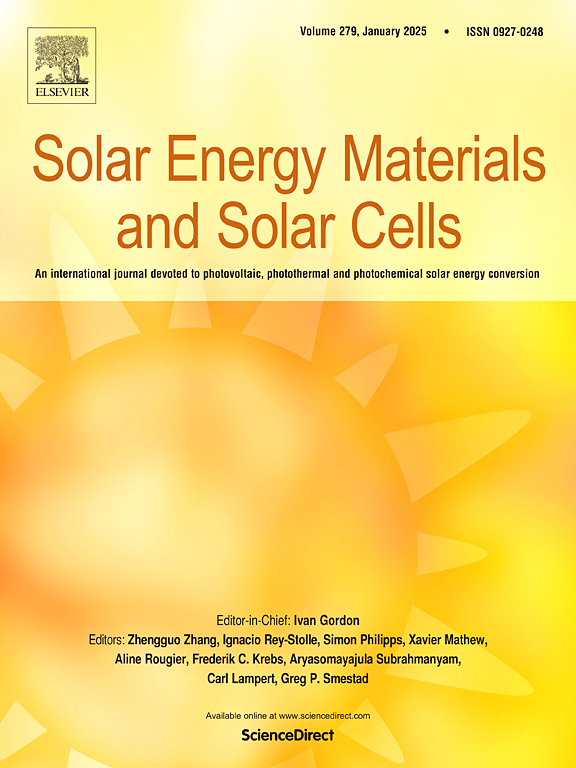硅异质结太阳能电池反应等离子体沉积锌锡氧化物透明导电层
IF 6.3
2区 材料科学
Q2 ENERGY & FUELS
引用次数: 0
摘要
铟基透明导电氧化物(TCOs)的稀缺性和成本波动严重阻碍了硅异质结(SHJ)太阳能电池的可持续发展。为了减少铟的使用,开发经济友好且具有适当工作功能的透明导电层已成为一个关键问题。在这里,我们报道了在室温下用反应等离子体沉积(RPD)生长ZnxSn1-xO透明导电薄膜的晶体硅异质结太阳能电池。同时,比较磁控溅射ICO(即Ce掺杂In2O3)和反应等离子体沉积生长GZO(即ga掺杂ZnO)透明导电层的SHJ太阳能电池作为参考。系统地研究了不同掺杂浓度ZnxSn1-xO薄膜的光学和电学性质。我们获得了zn0.17 sn0.83 o薄膜的最佳光电性能:低电阻率(5.57 × 10−3 Ω cm),高载流子迁移率(27 cm2/V·s)和类似于n型非晶硅(4.32 eV)的适当功函数。在磁控溅射ICO和n-a-Si:H之间集成了30 nm- zn0.17 sn0.830 o缓冲层,由于zn0.17 sn0.830 o的功函数与n-a-Si:H相似,在薄膜沉积过程中减少了界面损伤,表现出较高的少数载流子寿命和相对较高的Voc。SHJ太阳能电池的效率为20.76% (Voc = 730.48 mV, Jsc = 40.19 mA/cm2, FF = 70.51%)。本工作重点研究了rpd生长的ZnxSn1-xO透明导电层,并将其作为缓冲层应用于SHJ太阳能电池中,这将有助于促进SHJ太阳能电池光伏产业的发展。本文章由计算机程序翻译,如有差异,请以英文原文为准。
Zinc-tin oxide transparent conductive layers via reactive plasma deposition for silicon heterojunction solar cells
The escalating scarcity and cost volatility of indium-based transparent conductive oxides (TCOs) critically hinder the sustainable advancement of silicon heterojunction (SHJ) solar cells. In order to reduce the use of indium, developing economically friendly and having appropriate work function transparent conductive layers has become a key issue. Here, we report crystalline silicon heterojunction solar cells with reactive plasma deposition (RPD) grown ZnxSn1-xO transparent conductive thin films at room temperature. Meanwhile, SHJ solar cells with magnetron sputtered ICO (i.e. Ce doped In2O3) and reactive plasma deposition grown GZO (i.e. Ga-doped ZnO) transparent conductive layers are compared as references. The optical and electrical properties of ZnxSn1-xO thin films with different doping concentrations have been systematically studied. We achieved optimal optoelectronic properties of the thin film-Zn0.17Sn0.83O: a low resistivity (5.57 × 10−3 Ω cm), a high carrier mobility (27 cm2/V·s) and a proper work function similar to n-type amorphous silicon (4.32 eV). The integration of a 30 nm-Zn0.17Sn0.83O buffer layer between magnetron-sputtered ICO and n-a-Si:H exhibits a higher minority carrier lifetime as well as relatively higher Voc because the work function of Zn0.17Sn0.83O is similar to that of n-a-Si:H and the interface damage is reduced during the thin-film deposition process. The SHJ solar cell achieved an efficiency of 20.76 % (Voc = 730.48 mV, Jsc = 40.19 mA/cm2, FF = 70.51 %). This work highlights RPD-grown ZnxSn1-xO transparent conductive layers, and their application as the buffer layer in SHJ solar cells, which will help to promote the development of the SHJ solar cell photovoltaic industry.
求助全文
通过发布文献求助,成功后即可免费获取论文全文。
去求助
来源期刊

Solar Energy Materials and Solar Cells
工程技术-材料科学:综合
CiteScore
12.60
自引率
11.60%
发文量
513
审稿时长
47 days
期刊介绍:
Solar Energy Materials & Solar Cells is intended as a vehicle for the dissemination of research results on materials science and technology related to photovoltaic, photothermal and photoelectrochemical solar energy conversion. Materials science is taken in the broadest possible sense and encompasses physics, chemistry, optics, materials fabrication and analysis for all types of materials.
 求助内容:
求助内容: 应助结果提醒方式:
应助结果提醒方式:


